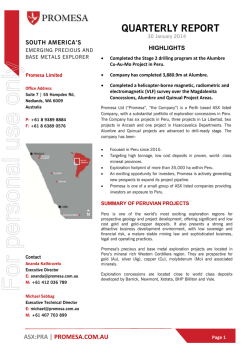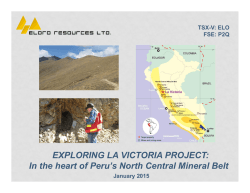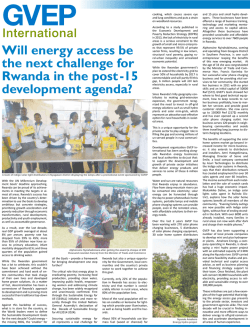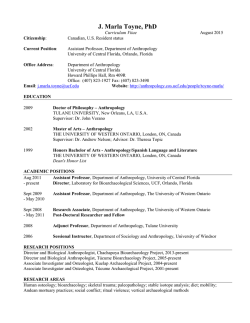
Peru Power_2014
This report was researched and written by Global Business Reports Alfonso Tejerina, Irina Negoita and Miguel Pérez-Solero. Power in Peru The country's potential is far from being fulfilled Although Peru has been one of the best-performing economies worldwide over the last decade, its energy sector is still small in absolute numbers. Consumption levels per capita are low, even by Latin American standards, and demand growth is highly dependent on new mining investments. Successive governments have kept energy prices low; and regional interconnection, which could provide the industry with considerable export revenues, especially to Chile, is not under immediate discussion. Yet investors continue to come. Generators continue developing new ventures, with the Peruvian state guaranteeing long-term pricing through power-purchase agreements (PPAs). Big consulting and construction firms have found in Peru a key emerging market to offset the decline of projects in Europe. With figures for installed capacity and energy consumption still at very modest levels, there is nowhere to go but up. Energy matrix - the hydro/gas balance While electricity generation was dominated by hydro until recently, in 2004 the arrival of natural gas from the Camisea fields was a transformational moment. By 2013, thermal gas generation already accounted for over 40% of the energy matrix, while hydro represented just 53%. Gas seems to have reached its peak, though. As critics voice their concerns that it is a finite resource and that it should anyways be used for more value-added processes (such as petrochemical plants), the government has announced its intention to give a new impulse to hydro generation. The National Energy Plan 2014-2025 states that 60% of the matrix should come from renewable resources, including traditional hydro. “We do not intend to increase the participation of gas”, Photo courtesy of Duke Energy. said Eleodoro Mayorga, Minister of Energy and Mines, who pointed out that at 7% growth levels in energy demand, the installed capacity will need to double in ten years time (it currently stands at less than 8 GW). According to data from the Ministry, the country is adding over 5 GW before 2021, consisting of 1.4 GW of thermal gas and diesel generation in the so-called ‘Southern Energy Node’; 200 MW at the Quillabamba thermal gas plant; 2.4 GW in hydro projects until 2018 and 1.2 GW of new hydro projects in a long-awaited tender process by ProInversión. Vice-Minister of Energy Edwin Quintanilla anticipates that, after a slower than expected 2014, growth will be strong for 20152017: “Energy demand will increase by no less than 10% annually over the next three years because there are infrastructure projects underway and new mines are going to be built. In that respect, growth is assured”. Peru's energy prices Roberto Santiváñez, partner at local law firm Santiváñez Abogados, suggested that the tender system with a regulated price needs to change: “The State just guarantees that a price will be paid by the users through tariff increases, yet the demand cannot absorb cost overruns forever. At some point there will be a breaking point”. Carlos García, Peru managing director of IMAP, an investment bank, said: “Today there is no hydro project with costs below $2 million per MW. How is it possible that we privatized Electrolima in 1994 with a price of $32/MWh and today we are at just $40/ MWh? This variation does not match inflation rates and is not sustainable”. Global Business Reports POWER PERU Eleodoro Mayorga, Minister of Energy and Mines That view is challenged by the government. “In all our tender processes there is competition. Investors always look for higher profits but today’s margins, sitting at around 12%, are reasonable”, said Carlos Herrera, Executive Director of ProInversión. As a result of low prices, the market for new hydro plants is increasingly populated by construction firms that can benefit from the synergies of building the projects themselves. Odebrecht Energía, for instance, is www.gbreports.com constructing the 456-MW Chaglla power plant. Another example is Isolux-Corsán of Spain, which won a contract to build the 302-MW Molloco hydro facility. ICA of Mexico, which has extensive experience building hydro projects for the CFE in its home country, is also entering the market. “We compete against gas, which is far cheaper than clean energy, so we do not have a level-playing field. Besides, the operator assumes all risks: design, construction, and energy sale. All these risks push costs up”, said Luis Flores Mancera, Regional Manager of ICA. César Butrón, President of COES, the industry regulator, said: “Definitely, the price of $45 per MWh cannot sustain the construction of hydro projects. Consumers, either distributors or large clients such as mining companies, will have to accept long-term contracts of $65-$70”. While this process is taking place, the current scenario of slower growth than expected in 2014 has pushed generators for increased efficiency. Duke Energy, for instance, decided to divest its Las Flores thermal gas plant, as it could not reach a good deal for gas supply. The company is focusing on optimizing its two hydro plants, Carhuaquero and Cañón del Pato, and an integrated gas facility, Aguaytía, for a total of 550 MW. “Energy prices have decreased since the startup of Camisea, and the country has accumulated savings of $20 billion. The challenge for generators like us is that we have to be more efficient “, says Raúl Espinoza, general manager of Duke Energy. Tatiana Alegre, general manager of Termochilca, which operates the Santo Domingo de los Olleros 209-MW thermal gas plant, explained that electricity demand was expected to expand by 12% in 2014, whereas it only grew by 5-6% in the end. “This has pushed marginal costs down, to around $20/MWh. For 2015 the prospects are better, but the spot market will continue at the same levels because the country is incorporating 1,000 efficient MW, and the demand is not growing by more than 650 MW, even if we count the expansion of Cerro Verde’s mining operation”. Alegre says power supply is guaranteed at least until 2022, and that the country needs to handle carefully the promotion of new power projects under regulated schemes, since a growth rate below 8% annually in energy demand will create an excess of supply. Handling systemic risk As demand has been consistently expanding over the last years, the system has suffered from a number of bottlenecks. Among the short-term, immediate risks the installed capacity has been relying heavily on the Mantaro 1-GW hydro complex, run by state company Electroperú, and more recently on the thermal gas plants located in Chilca, 60 km south of Lima. Mantaro has been unable to stop the operation for tunnel maintenance for the last 40 years. Specialists assure there should be an inspection at least every 10 years, or tunnel failure could bring the plant to a halt. In Chilca, combining the output of the different plants by Kallpa (IC Power), Enersur (GDF Suez), Fenix Power (Ashmore Group) and Termochilca, there are around 2.5 GW that rely on one single pipeline that brings the gas from Camisea. The whole system is therefore fragile to breakdowns or terrorist attacks. “If the gas flow is interrupted for 2 Global Business Reports // POWER PERU February 2015 Global Business Reports www.gbreports.com POWER PERU any reason, there would be a blackout for 20% of demand at peak hours”, said César Butrón of COES. Moving forward, the risk should be mitigated by the construction of the southern gas pipeline and the availability of thermal plants that can work with diesel in case of emergency. Then, there is long-term risk. Gas, of course, is a non-renewable resource, and consumption has been expanding dramatically over the last decade. With plans for a northern gas pipeline and petrochemical sites, how long gas supplies will last can only be known in the years to come. Finally, there is climate change, which could affect hydropower generation. In the words of Pablo Ferradas, managing director of Lahmeyer Agua y Energía, a consultancy specialized in hydropower projects: “Climate change is a fact. Glaciers have decreased by 40%. Moving forwards, we will need more reservoirs to regulate water flows. Rainy years will be rainier, and dry years will be drier. Unfortunately, reservoirs have impacts with the inundation of cultivable land and the relocation of communities”. Non-conventional renewables Non-conventional renewables accounted for 3% of the energy matrix in 2014, a figure expected to reach 5% in 2015 (this does not include small hydro). Investors in wind and solar projects are anxiously waiting for the details of the next renewable energy auction (‘RER’) to be released. New projects should be awarded by the Government in mid-2015. Juan Coronado, general manager of Auster Energía, was the first developer to obtain Gas-fired generation represents over 40% of the energy matrix. Photo courtesy of Termochilca. February 2015 Global Business Reports // POWER PERU 3 Global Business Reports POWER PERU contracts for wind farms in Peru. He explained: “In order to reach the 5% required by law, the country will need about 1,600 GWh or 400 MW of new capacity to be distributed among wind, solar and biomass”. Auster is now partnering with Invenergy of the U.S. for the development of new power generation projects in the country. Daniella Rough, specialist for energy services at Golder Associates, an engineering and environmental consultancy, pointed out: “With the COP20 [Climate Change Conference, held in Lima in December 2014] there are many expectations for government support for renewables, including removing the restriction on selling wind and solar energy privately via the national grid”. The latter point is significant since, according to the regulation, the firm capacity for wind and solar plants is zero. That means investors in these technologies can only enter the market via PPAs with the Government through the RER auctions. Combining all of the RER auctions completed so far and excluding small hydros, the Government has signed PPAs for four 4 Global Business Reports // POWER PERU www.gbreports.com wind farms (for a total of 232 MW), five solar plants (96 MW) and two biomass facilities (27 MW). The main argument against new power generating technologies is their cost. Yet, as the industry develops, these should come down, thanks to innovative technologies and economies of scale. Indeed, wind energy is offered in Peru at prices as low as $50-65/MWh, which is competitive with hydro plants. Meanwhile, solar energy is being offered at less than $90/MWh under long-term contracts. “Technology and wind quality are helping us reduce costs. I do not think that the prices of the last auctions will be successful again, so it is very important to bring costs down”, said Patricia Alarcón, country manager of ContourGlobal, a firm that operates the Talara and Cupisnique wind farms. Cost is not the only concern for advocates of unconventional sources of energy. While there have been comprehensive hydrological studies since the 1960s, not the same can be said about wind and solar. More years of data collection are needed to increase Peru has very constant winds along its coast: Photo: Marcona wind farm, courtesy of Cobra. certainty over the performance of new energy sources. So far the figures are promising though, with very high radiation levels in the south of the country (6-7 kWh per square meter) and very constant winds along the coast. “The wind in Marcona is exceptional”, said María Sánchez-Mayendía, manager of Renewable Energies at Cobra, a Spanish group that operates the Marcona wind farm (32 MW) and is building another one at Tres Hermanas (97 MW). “Our studies say that we have 4,600-4,800 hours of wind per year. In Spain you do not have plants with such wind quality. Moreover, wind is very stable, not turbulent. That means that the units can generate virtually all the time”. The results coming from solar are also very satisfactory, said Alfonso de Sas, country manager of Isolux-Corsán, a company that put two 22-MW solar plants in operation in 2012 in Arequipa. “These plants are a source of pride, technologically speaking, because they are injecting into the grid 25% more energy than expected,” he said. Solar will play a key role in the Government’s effort to increase rural electrification rates. In November 2014, Tozzi Group company Ergon Peru won a contract to install up to 500,000 off-grid solar panels. While technological innovation will bring the cost of renewable power generation down, the country’s learning curve over the last years should also accelerate the development of this segment. Today companies awarded PPAs need to provide financial deposits of $250,000 per MW, as explained by Jesús Tamayo, president of Osinergmin, the government body that handles the process. “Deposits have been increasing because we are trying to assure the outcome of the auction, with the companies winning conFebruary 2015 Global Business Reports www.gbreports.com POWER PERU tracts showing enough commitment and financial capacity to start ventures, allow for lower-impact, more sustainable projects. “The the projects immediately”. advantage of run-of-the-river projects with small reservoirs and Environmental regulations should also keep up with the country’s lagoons is that they do not use a large amount of land and they latest developments. According to Gonzalo Morante, general mancan be used for irrigation projects in some cases. Also, a big part ager of Walsh, a large environmental consultancy: “The power of the infrastructure can be built underground. Since these sector regulation in Peru is pretty old and is framed on projects are medium-sized or small, they keep the a model that exclusively had hydroelectric and limnatural flow of the water, so you can add more ited thermoelectric sources. It is therefore very facilities along the river. Peru has ideal condidifficult to apply it to wind, solar and geothertions for these type of schemes”, affirmed mal projects where we have to look at the best Mario Marchese, general manager of Hatch, practices around the world”. a consultancy increasingly active in energy “Unfortunately”, Morante continues, “the regprojects in Peru. ulators lack experience and the legal frameThose who want to picture the opportuwork does not allow them to be very flexible. nities for hydro projects in Peru can just However I think that, in the end, we can work take the Carretera Central eastbound from together with the regulator and come up with a Lima. In a matter of just 120 km, travelGunnar Frostberg, general manager, system that actually focuses on what is important ers go from sea level to nearly 5,000 meters Norconsult for each project.” in the Ticlio mountain pass. The topography on the eastern side of the mountain range is perhaps less abrupt, but rivers towards the jungle have richer water Since the start of the RER model, the Government has also signed flows, and these are attracting interest as well. “In the future, big PPAs for 44 mini-hydro plants of less than 20 MW for a total of 391 hydro projects will be developed on the eastern side of the Andes. MW. The players developing these small-scale projects include Latin Many clients are now looking at the Marañón river, which has a America Power, Union Group, Alarde, Aluz Clean Energy, Rurelec, great potential. There are lower heads there, but a lot of water”, IBT and others. explained Gunnar Frostberg, general manager of Norconsult, a Mini-hydros, although more expensive to build per MW than larger Norwegian-based consultancy specialized in hydro projects. Hydro potential February 2015 Global Business Reports // POWER PERU 5 Global Business Reports POWER PERU “There are many projects in the Marañón River with power potentials of 500 MW each or more. They will take some time to be built because it is a more remote area and there may be more environmental implications to be taken care of”, Frostberg continued. While hydropower projects in the jungle need to be very careful about environmental aspects, these projects can be instrumental in bringing development to areas previously dominated by drug trafficking mafias. The Monzón valley, a no-go region just a few years ago, saw a successful coca eradication program by the government, and now private players are investing in the area. “In 2011, there were no police stations in the region; today you have many, together with bank branches in all the villages. Schooling rates have increased significantly since kids are not forced to work in the coca fields”, said Héctor Bonilla, CEO of Union Energy Group, a company building two hydro facilities. These plants were initially identified by Andes, a project promoter, who also did the initial work for Belo Horizonte, a 180-MW pro- 6 Global Business Reports // POWER PERU www.gbreports.com ject now owned by Odebrecht in the same Monzón valley. Putting together the different projects, the region could see investments of over $600 million. “This is an unimaginable amount for the Monzón valley, and it is going to change the region’s economy”, said Juan Antonio Solidoro, executive partner of Andes. In the end, it all comes down to sustainability. Hydro projects have certain environmental impacts and, while they generate many jobs during construction, they barely provide any employment after that. This is why generators need to incorporate sustainability initiatives from the beginning of projects. In the words of Ferradas of Lahmeyer Agua y Energía: “You need to worry about the communities, not just about the internal rate of return”. Transmission and distribution With a large chunk of the generation capacity concentrated in the center of the country, Peru has had to invest heavily on its transmission network over the last years. The Erlon Arfelli, director, Odebrecht Energía first 500 kV lines were put to work in 2011, and the country continues its efforts to reach remote populated centers. Last year, the government awarded Isolux-Corsán the concession to build and operate the 630-km, 220 kV line from Moyobamba to Iquitos, deep in the Amazon jungle. Today, the main two players in transmission are ISA of Colombia, which controls around 75% of the infrastructure, and Abengoa of Spain, which recently completed the Carhuamayo-Carhuaquero 670-km 220-kV line and the 900-km 500-kV line between Chilca and Montalvo; an investment worth $500 million. Ignacio Baena, president of Abengoa Perú, explained that a key challenge was to manage the altitude, with segments running at over 5,000 meters above sea level. “In both projects it was very hard to obtain the right of way, due to social problems and excessive expectations. As part of this process, very often we need to implement projects that get mixed up with corporate social responsibility, since these are initiatives that should be carried out by the State”, he said. The ISA Group currently operates 9,600 km of lines in Peru and is building the country’s longest, the Mantaro-Montalvo 500 kV line that runs along 1,300 km. Its general manager, Carlos Mario Caro, explains that over the last 10 years Peru has doubled its transmission infrastructure, making the system far more reliable. “As ISA we have reliability rates of 99%”, he said. The State still plays an important role in the distribution segment. Outside of the capital, where the business is controlled by two private players, Luz del Sur and Edelnor, most of the companies are State-owned. One of which is Distriluz, which serves 2.2 million February 2015 Global Business Reports POWER PERU www.gbreports.com clients. Like Electroperú in power generation, Distriluz cannot obtain debt financing for a period of more than 12 months. A project by the government to partially privatize State-owned companies (up to a 40% stake) was recently rejected by Congress. “A transformer can be operational for 25-30 years, yet we need to pay for it in a year. We have good cash flow, but we cannot invest”, laments Humberto Montes, president of Distriluz. In this context, and provided that the political landscape allows for it, the modernization of State-owned electricity companies should be a priority for the authorities. The Colombian model could serve as a good example. given time. This is a dream for 2025”, said Carlos Mario Caro of ISA. Technology and services The growth of Peru’s energy sector has been a magnet for international technology providers. Energy represents 60% of total turnover for Siemens in Peru, with an important presence in gas and windpower generation; Vestas supplied the turbines for ContourGlobal’s two wind farms; Voith is expanding its Lima office to serve Peru’s expanding hydro sector and Alstom, whose energy business was recently acquired by GE, is also present in the country with the Chaglla 456-MW hydro plant as one of its latest projects. The same goes for consultants and engineering firms. Hatch is focusing on growing its Lima operation, putting emphasis Regional interconnection The export potential The previous administration of President Alan García tried to promote large hydropower projects in the Peruvian jungle, with the idea of exporting electricity to Brazil. The emblematic project in this respect was Inambari, a 2.2 GW hydro complex that is currently on hold. Asked about Inambari, local expert in hydropower Julio Bustamante, general manager of JByA, said: “The area is occupied by informal miners and illegal loggers. There is also drug trafficking. These are the people that oppose Inambari because the plant would bring governmental entities there. If you look at Itaipú, the results there have been fantastic. Something like this could be achieved in Inambari”. The point is that not only social and environmental aspects are at stake; there is also politics, and public opinion does not seem in favor of exporting electricity to Brazil or Chile. “There is a perception that Peru suffers from an energy shortage. I have never read a line in the newspapers complaining about copper exports, but when you talk about exporting gas or electricity, many people are against it,” said Erlon Arfelli, director of Odebrecht Energía. For ISA of Colombia, making South America an integrated energy market makes total sense. “All Latin American countries should be connected as happens in Europe. When it rains in Peru, perhaps it is not raining in Colombia, and vice-versa. With total integration from Central to South America, you would have electricity dispatched by the country that can offer the cheapest price at any February 2015 Global Business Reports // POWER PERU 7 Global Business Reports POWER PERU on the mining and energy sectors. Besides traditional hydro projects, Pöyry has been successful in adapting to the more demanding cost structures of mini-hydros under 20 MW, in order to win more work. Posco of Korea has had an office in Lima for several years now and Norconsult arrived in Peru with a project for Statkraft’s Cheves plant, but it intends to capitalize upon its hydro and tunneling expertise to establish a per- 8 Global Business Reports // POWER PERU www.gbreports.com manent base in the country. “Peru’s growth can be compared to what happened in Chile in the 1990s, with a big momentum in mining, infrastructure and energy projects”, explained Mario Marchese of Hatch. Roland Schmidt, managing director of Pöyry in Peru, agreed: “The country’s economy has shown impressive growth rates over the last decade, and Peru has one of the best investment ratings of all South America, similar to Chile. Nobody would have believed it 10 years ago”. The case is also made that Peru is actually in a better position than Chile to provide revenue to technology and services providers. B.Bosch, a large Chilean player in the manufacturing of structures for transmission lines, substations and more recently solar panels, has been serving the Peruvian market since the 1990s. The company has found a niche in providing turnkey solutions for generators and mining companies that have mediumsized and small investment projects. “A majority of Chile’s industrial players already participate in the Peruvian market and many of them are setting up shops in Peru because in Chile the conditions for new investment projects are not met. There is an exodus of Chilean professionals and companies towards Peru. Chile is growing at 2% rates, whereas Peru has been growing by up to 8-9%. A bad year in Peru means 4% growth,” said Ariel Burgos, commercial manager of B.Bosch Industrial. Chilean players are not the only ones to arrive on the market. Chinese and Indian manufacturers are also trying to get a bigger slice of the pie with the support of Peruvian distributors. Local company Electrowerke, for instance, represents Crompton Greaves (CG) of India, a company that has become a leading player in Peru’s market for 500 kV transformers. Another example is Ergon Power that represents equipment brands such as Harbin Electric Machinery (HEC) of China. “When we started working with Harbin in 2006 there was resistance to buy Chinese equipment, but Harbin is a well recognized brand that had an important participation in the Three Gorges Dam project in China. They can turn out 14,000 MW worth of equipment every year, and that translates into faster delivery times, so the client can put its plant into production earlier,” said Ricardo Velasco, general manager of Ergon Power. The company also represents Chinese EPC companies, including Gezhouba Group (CGGC) and Sepco III. Peru’s growth expectations and macroeconomic stability seem to justify all this international interest. From hydro to natural gas and non-conventional renewables like wind and solar, the country should continue capitalizing on its potential in the years to come. • February 2015
© Copyright 2025






